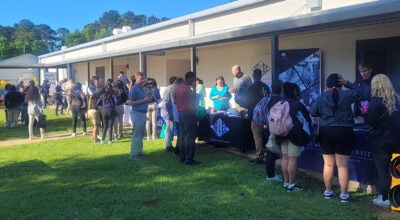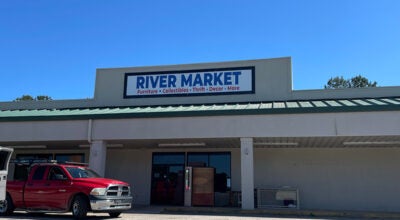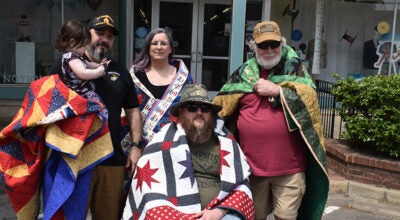Thompson speaks to Rotary Club
Published 8:34 am Saturday, August 15, 2020
|
Getting your Trinity Audio player ready...
|
LANETT — Joe Thompson discussed Thursday a topic he often talks about in period uniform at places like Horseshoe Bend, Fort Toulouse and U.S. Army Infantry Museum in Columbus. He’s a member of the cannon crew and often leads firing demonstrations. He was in street clothes when he talked about the pre-Civil War period as the guest speaker at Thursday’s noon hour meeting of the West Point Rotary Club, held at the Jane Farrar Event Center in downtown Lanett.
Thompson talked about how the Creek War in 1813-14 played a big part in West Point becoming a town.
The Creeks’ devastating defeat at the hands of Andrew Jackson and his forces resulted in the Treaty of Fort Jackson, in which the Creeks gave up more than 20 million acres of land to the U.S. The southern one-fourth of Georgia and most of the present state of Alabama came from the treaty.
That treaty signaled the coming settlement of the two states. The immediate opening of the west-central Georgia region to settlers moving in was sealed by the Treaty of Indian Springs in 1826. In it, William McIntosh agreed to give up a lot of land in what’s now Georgia in exchange for $400,000 and a similar amount of land in what is now Oklahoma.
A large number of Creeks led by Menawa of Horseshoe Bend fame went to his home in present-day Carroll County, surrounded it and set it on fire with McIntosh inside. Women, children and other members of the household were allowed to leave before the place was torched. As McIntosh escaped the burning building, he was shot and stabbed many times by the vengeful group of Creeks. One of the survivors that day was McIntosh’s son, Chilly.
Sometime after that, as he was emigrating to the new Creek lands in Oklahoma, Chilly stopped at a tavern in Columbus and presented the owner with a portrait of his dad and asked for it to be displayed there, where it hung for many years. It’s now on display at the Alabama Department of Archives and History and is one of only two known original images of the famed chief.
Though the Creeks didn’t like it, the Treaty of Indian Springs pretty much ended their presence in Georgia. Ironically, one of McIntosh’s own kinsmen was a major promoter of settlement by whites.
“Governor George M. Troup was MsIntosh’s cousin,” Thompson said. “He wanted the land in west Georgia opened up. E.Y. Hill went to the state capital in Milledgeville to get a charter for a new town on the Chattahoochee River. They wanted to call in Franklin, but that name was already taken.”
Having two Franklins, the other being the county seat of neighboring Heard County, created so much confusion that the one in Troup County changed its name to West Point in the early 1830s.
The name reflects the westernmost point of the Chattahoochee River.
Thompson said that West Point got a charter from the state in 1838 to have a toll bridge linking the town’s east and west banks.
West Point’s second bridge was a railroad bridge. It was built in 1854 to link West Point to two major cities, Atlanta and Montgomery.
“As early as the 1830s, railroads were being built in Georgia and Alabama,” Thompson said. “There was a need to get cotton from the fields to the wharfs.”
At one time, the ports of Savannah and Mobile were two of the busiest in the U.S., largely due to cotton being exported to England.
Atlanta is the city it is today because it’s the place where a north-south bound railroad and an east-west railroad crossed. The same thing later happened with highways and airlines.
West Point was already an incorporated city when a place called Terminus first appeared on a map in 1843, not far from Cousin John Thrasher’s store. It later became Marthasville and eventually Atlanta.
“Car sheds were built in these terminal towns,” Thompson said. “West Point had one near the Georgia-Alabama state line. It looked very much like the ones built in Atlanta, Augusta and Macon.”
Car sheds protected locomotives and passenger coaches from the rain.
Thompson said that a man named Lemuel P. Grant was big in early railroading in Georgia. The town of Grantville and Grant Park in Atlanta are named for him. The original name for Grantville was Calico Corners. The train depot in Grantville is the only one left that resembles the depots of the nineteenth century, Thompson said.
Not everyone was in agreement that having a railroad in your town was a good thing.
“Some people thought they were too loud and were a fire hazard,” Thompson said. “Some people said that chickens wouldn’t lay their eggs when trains came through.”
Most people thought the good outweighed the bad and that having a railroad was a good thing. It was the most rapid mode of transportation for its day. One could board a train and go almost anyplace.
An early problem with rail transportation was that the rails didn’t have the same gauges. Some states in the south had the South Carolina standard gauge of five feet. Other states had the English system of four feet, eight and a half inches.
With Alabama and Georgia having different gauges, trains had to stop at the state line. Goods had to be taken off the trains and either stored in warehouses or transported across the state line to awaiting boxcars in the other state. This is what made West Point an inviting target to Union cavalry in 1865. They came to burn the warehouses, the bridges, the locomotives and the railroad stock.
Another necessity for early West Point were turntables. They were operated by hand and allowed locomotives to travel in the opposite direction.
West Point’s wagon bridges and railroad bridges had their own distinctive look. The wagon bridges went straight across from one side to the other. The rail bridges have always crossed at the same angle. This allows trains to run fairly close to the river on the west side.
According to Thompson. West Point’s first railroad bridge was of the House truss style.
“It had lots of iron and timber,” he said. “It was some 622 feet in length and cost $22,000 to build.”
The original name for West 7th Street was Bridge Street. That’s where the first wagon bridge crossed the river.
Locomotives were named for prominent Georgians. There was an E.Y. Hill, an A.O. Bull and a Dr. Thompson.
A very valuable resource to historians are the Sanborn Fire Insurance maps. They go back to 1885. Thompson said they reveal some interesting details about the period.
“They show a large cistern that was located downtown,” Thompson said. “It’s still there under the street. It was used for the last time when Jacobs Drugs caught fire in 1925.”
Historic photos reveal interesting details as well.
In the post Civil War era, the West Point Iron Works was located on the vacant lot where Point University today has plans for a dormitory. An early photo shows that the plant was at one time powered by a locomotive boiler.
One of Thompson’s favorite old photos from West Point was taken from the top of the Opera House and shows bridge construction going on at the river. Located on the corner of West 3rd Avenue and West 8th Street, the Opera House was located on the top (third) floor of the Lanier Building. It was torn away in a March 1920 tornado and never rebuilt. It was a major entertainment venue in its day and had many sold-out audiences composed of people who were staying overnight in West Point while traveling on the Southern Crescent, going by rail between New Orleans and Washington, D.C.
ROTARY CLUB PROGRAM — Joe Thompson (at center) talked about the early history of West Point, its settlement and its historic bridges at Thursday’s noon hour meeting of the West Point Rotary Club. At left is Rob Huling, club president, and at right, Joe Hill, program chair.






